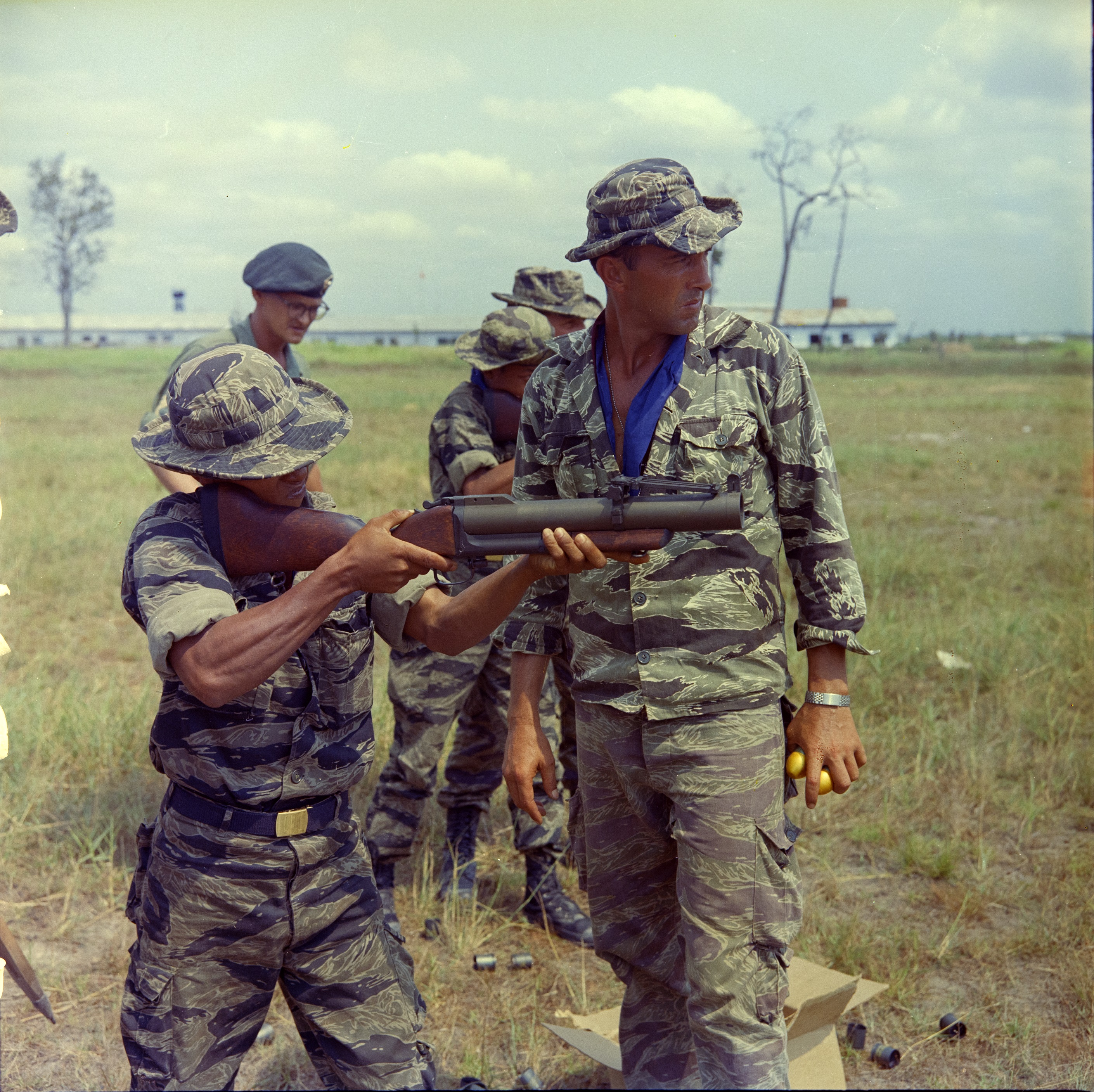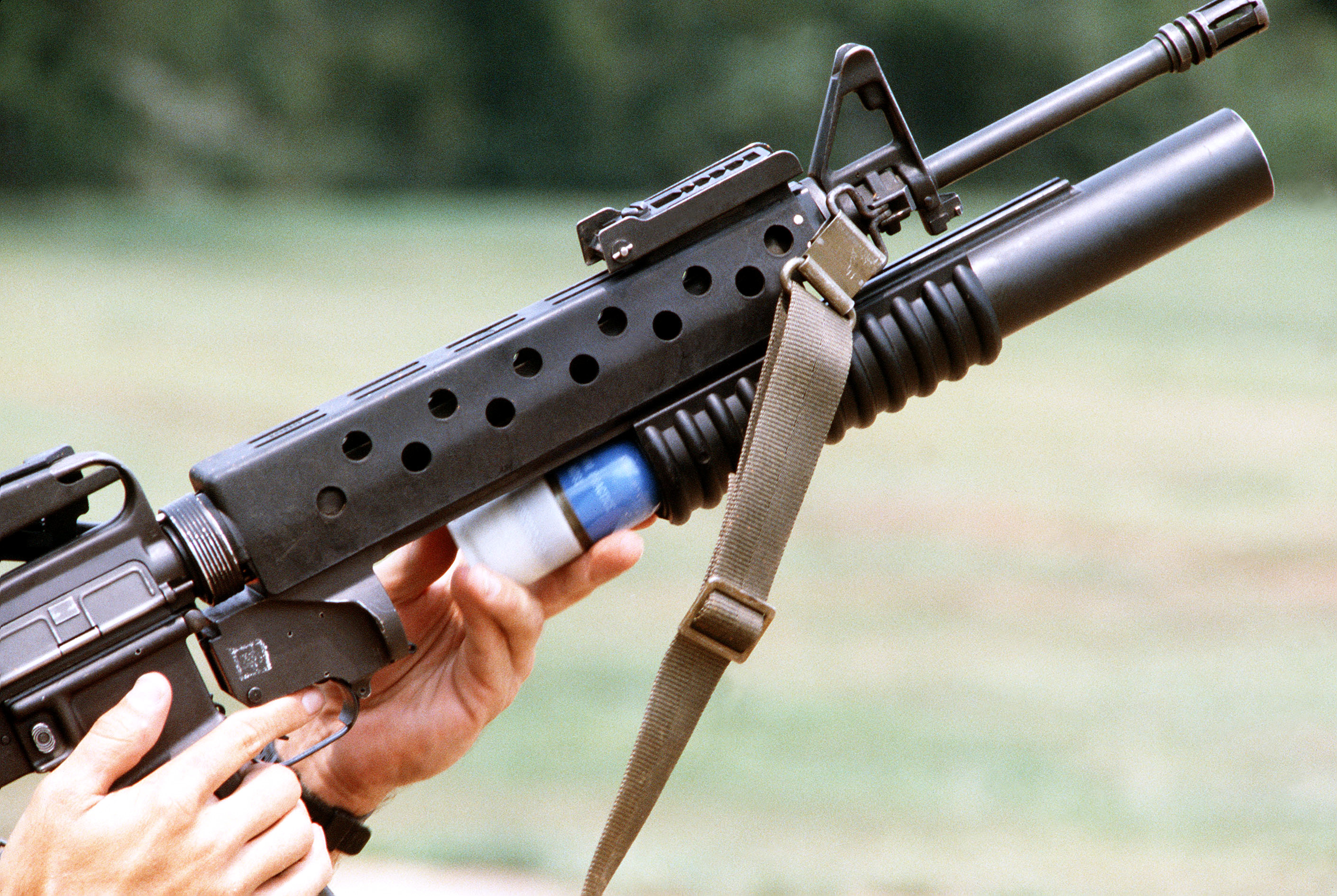|
Weapons Company
A weapons company, sometimes called a manoeuvre support company, is a company-sized military unit attached to an infantry battalion to support the rifle companies of the battalion. It usually possesses some combination of machine-guns, mortars, anti-tank missiles, anti-aircraft missiles, reconnaissance vehicles and, sometimes, assault pioneers (infantrymen specially trained in the assault role). British Army In the British Army, the manoeuvre support company possesses an Anti-Tank platoon armed with 8 Javelin missile launchers, a reconnaissance platoon, a mortar platoon (with eight L16 81mm mortars), an assault pioneer platoon, and, in the case of Light Role battalions, a machine gun platoon (with nine FN MAG general purpose machine guns). United States Marine Corps In the United States Marine Corps, the infantry battalion weapons company is tasked with providing supporting fire for the three rifle companies that (along with the battalion's headquarters and service company) ... [...More Info...] [...Related Items...] OR: [Wikipedia] [Google] [Baidu] |
Company (military)
A company is a Military organization#Commands, formations, and units, military unit, typically consisting of 100–250 soldiers and usually commanded by a Major (rank), major or a Captain (armed forces), captain. Most companies are made up of three to seven platoons, although the exact number may vary by country, unit type, and structure. Usually several companies are grouped as a battalion or regiment, the latter of which is sometimes formed by several battalions. Occasionally, ''independent'' or ''separate'' companies are organized for special purposes, such as the Air Naval Gunfire Liaison Company, 1st Air Naval Gunfire Liaison Company or the 3rd Force Reconnaissance Company. These companies are not organic to a battalion or regiment, but rather report directly to a higher level organization such as a Marine Expeditionary Force headquarters (i.e., a corps-level command). Historical background The modern military company became popularized during the reorganization of the S ... [...More Info...] [...Related Items...] OR: [Wikipedia] [Google] [Baidu] |
Headquarters
Headquarters (often referred to as HQ) notes the location where most or all of the important functions of an organization are coordinated. The term is used in a wide variety of situations, including private sector corporations, non-profits, military organizations, religious groups, sports leagues and so on. It usually implies a geographically dispersed organization with a clear hierarchical structure. Corporate In the private sector, the corporate headquarters is the entity at the top of a corporation that takes responsibility for managing all business activities. The value added, intended benefit of headquarters is to carry out purposeful regulatory capacity and ensure corporate governance. The corporate headquarters is a key element of a corporate structure and covers different corporate functions including strategic planning, corporate communications, corporate tax, tax payments, legal, legal operations, marketing, finance, human resources, information technology, and pr ... [...More Info...] [...Related Items...] OR: [Wikipedia] [Google] [Baidu] |
Communications Platoon
In the USMC, a communications platoon, also known as the "S-6", is responsible for all related communications for the battalion. It is part of the Headquarters and Service Company, Headquarters and Services Company and is responsible for supporting all companies within the battalion. At the regiment level, the communications platoon is responsible for providing support to the regiment as well as the battalion communication platoons. Within the communications platoon, there are four sections: Data, Wire, Radio, and Maintenance. Each of these sections have specialized individuals who have been trained to best understand their field. Leadership The communications platoon is headed by a 2nd or 1st Lieutenant, called the Communications Officer or S-6, and a Master Sergeant, called the Communications Chief. For regiment level communication platoons, it's typical to have a Captain head the platoon and a Master Gunnery Sergeant be the senior enlisted Marine. Each section has a chief that i ... [...More Info...] [...Related Items...] OR: [Wikipedia] [Google] [Baidu] |
Radio Operator
A radio operator (also, formerly, a wireless operator in British and Commonwealth English) is a person who is responsible for the operations of a radio system and the technicalities in broadcasting. The profession of radio operator has become largely obsolete with the automation of radio-based tasks in recent decades. Nevertheless, radio operators are still employed in maritime and aviation fields. In most cases radio transmission is now only one of several tasks of a radio operator. In the United States, the title of Certified Radio Operator is granted to those who pass a test issued by the Society of Broadcast Engineers. The role of 'Wireless Operator' aboard aircraft during WWII was often abbreviated to 'WOp' or 'WOP' in official documents or obituaries. See also * Wireless telegraphy Wireless telegraphy or radiotelegraphy is the transmission of text messages by radio waves, analogous to electrical telegraphy using electrical cable, cables. Before about 1910, the ... [...More Info...] [...Related Items...] OR: [Wikipedia] [Google] [Baidu] |
Squad Leader
''Squad Leader'' is a tactical level board war game originally published by Avalon Hill in 1977. It was designed by John Hill and simulates on infantry combat in Europe during World War II. One of the most complex war games of its time, ''Squad Leader'' is the natural extension of the trend towards greater realism (and hence complexity) initiated by several earlier games, including Avalon Hill's own '' PanzerBlitz'' and '' Panzer Leader''. Those two earlier games were slightly larger in scope, with counters representing platoons and map hexes measuring 250 metres across, compared to Squad Leader's 40 meter hexes and squad sized units. The original ''Squad Leader'' was produced in time to debut at Origins 1977. (The original print run of 2,500 copies had purple boxes which have become collectors' items.) Avalon Hill sold well in excess of 100,000 games of ''Squad Leader'', making it one of the most successful war games ever made. Combined with the sales of '' Advanced Squad ... [...More Info...] [...Related Items...] OR: [Wikipedia] [Google] [Baidu] |
Forward Observers In The U
Forward is a relative direction, the opposite of backward. Forward may also refer to: People * Forward (surname) Sports * Forward (association football) * Forward (basketball), including: ** Point forward ** Power forward (basketball) ** Small forward * Forward (ice hockey) ** Power forward (ice hockey) * In rugby football: ** Forwards (rugby league), in rugby league football ** Forwards (rugby union), in rugby union football * Forward Sports, a Pakistan sportswear brand * BK Forward, a Swedish club for association football and bandy Politics * Avante (political party) (Portuguese for ''forward''), a political party in Brazil * Endavant (Catalan for ''forward''), a socialist pro-independence organization in Catalonia * Forward (Belgium), a political party in Belgium * Forward (Bosnia and Herzegovina), a political party in Bosnia and Herzegovina * Forward (Denmark), a political party in Denmark * Forward (Greenland), a political party in Greenland * Forward Party (United ... [...More Info...] [...Related Items...] OR: [Wikipedia] [Google] [Baidu] |
Platoon Leader
A platoon leader (NATO) or platoon commander (more common in Commonwealth militaries and the US Marine Corps) is the officer in charge of a platoon. This person is usually a junior officer – a second or first lieutenant or an equivalent rank. The officer is usually assisted by a platoon sergeant. Some special units, such as specific aviation platoons and special forces, require a captain as platoon leader, due to the nature and increased responsibility of such assignments. Platoons normally consist of three or four sections (Commonwealth) or squads (US). Responsibilities of a Platoon Leader The duties and responsibilities of a platoon leader is similar in the armies. Based on the US Army publications,ATP 3-21.8, https://armypubs.army.mil/epubs/DR_pubs/DR_a/ARN13842-ATP_3-21.8-001-WEB-4.pdf, Last accessed: 03.02.2023 it is possible to address that a platoon leader: * Leads the platoon in supporting the higher headquarters missions. He bases his actions on his assigned ... [...More Info...] [...Related Items...] OR: [Wikipedia] [Google] [Baidu] |
Grenade Launcher
A grenade launcher is a weapon that fires a specially designed, large caliber projectile, often with an explosive, Smoke screen, smoke, or tear gas, gas warhead. Today, the term generally refers to a class of dedicated firearms firing unitary grenade Cartridge (firearms), cartridges. The most common type are man-portable, shoulder-fired weapons issued to individuals, although larger crew-served launchers are issued at higher levels of organization by military forces. Grenade launchers are produced in the form of standalone weapons (either Single-shot, single shot or Repeating firearm, repeating) or as attachments mounted to a parent firearm, usually a rifle. Larger crew-served automatic grenade launchers such as the Mk 19 grenade launcher, Mk 19 are mounted on Weapon mount, tripods or vehicles. Some armored fighting vehicles also mount fixed arrays of short-range, single-shot grenade launchers as a means of defense. History Early precursors The earliest devices that could ... [...More Info...] [...Related Items...] OR: [Wikipedia] [Google] [Baidu] |
40 Mm Grenade
This is a general collection of the world's many types of ammunition for grenade launchers in caliber. Several countries have developed or adopted grenade launchers in 40 mm caliber. NATO NATO currently uses three standardized 40 mm grenade families: 40 mm low velocity (LV), 40 mm medium velocity (MV), and 40 mm high velocity (HV). Low- and medium-velocity cartridges are used for different hand-held grenade launchers, while the high-velocity cartridge is used for automatic grenade launchers. 40×46 mm LV (40 mm low velocity) ''40×46 mm LV'' (''low velocity'') is a NATO-standard high–low grenade launcher cartridge meant for hand-held grenade launchers, such as the M79, M203, Milkor MGL, Heckler & Koch AG36 and M320 Grenade Launcher Module. The propellant has low pressure and gives the projectile an average velocity of depending on the ammunition type. 40 mm low-velocity ammunition types (NATO) Besides combat ammo there also exists crowd control a ... [...More Info...] [...Related Items...] OR: [Wikipedia] [Google] [Baidu] |
Mk 19 Grenade Launcher
The Mk 19 grenade launcher (pronounced Mark 19) is an American 40 mm belt-fed automatic grenade launcher that was first developed during the Vietnam War. Overview The Mk 19 is a belt-fed, blowback-operated, air-cooled, crew-served, fully-automatic weapon that is designed not to cook off. It fires 40 mm grenades at a cyclic rate of 325 to 375 rounds per minute, giving a practical rate of fire of 60 rounds per minute (rapid) and 40 rounds per minute (sustained). The weapon operates on the blowback principle, which uses the chamber pressure from each fired round to load and re-cock the weapon. The Mk 19 can launch its grenade at a maximum distance of , though its effective range to a point target is about , since the large rear leaf sight is only graduated as far. The nearest safe distance to launch the grenade is 310 meters in training and 75 meters in combat. Though the Mk 19 has a flash suppressor, it serves only to save the eyesight of its ope ... [...More Info...] [...Related Items...] OR: [Wikipedia] [Google] [Baidu] |
M2 Browning Machine Gun
The M2 machine gun or Browning .50-caliber machine gun (informally, "Ma Deuce") is a heavy machine gun that was designed near the end of World War I by John Browning. While similar to Browning's M1919 Browning machine gun, which was chambered for the .30-06 cartridge, the M2 uses Browning's larger and more powerful .50 BMG (12.7 mm) cartridge. The design has had many designations; the official U.S. military designation for the infantry type is Browning Machine Gun, Cal. .50, M2, HB, Flexible. It has been used against infantry, light armored vehicles, watercraft, light fortifications, and low-flying aircraft. The gun has been used extensively as a vehicle weapon and for aircraft armament by the United States since the 1930s. It was heavily used during World War II, the Korean War, the Vietnam War, the Falklands War, the Soviet–Afghan War, the Gulf War, the Iraq War, and the War in Afghanistan. It is the primary heavy machine gun of NATO countries and has been used by man ... [...More Info...] [...Related Items...] OR: [Wikipedia] [Google] [Baidu] |







